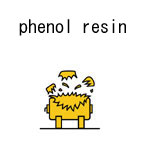| Case Name |
Rupture of metal drum cans containing extracted reaction liquid at a manufacturing plant of phenolic resin |
| Pictograph |

|
| Date |
May 30, 1990 |
| Place |
Kawasaki, Kanagawa, Japan |
| Location |
Chemical factory |
| Overview |
The vacuum device failed when the phenolic resin manufacturing reaction approached its end, which made it impossible to lower the temperature by vaporizing water. Therefore, there was a risk of the progress of gelation (solidification). Cresol was added for cooling, and the contents of the reactor were put into metal drum cans. These metal drum cans exploded after a while. Although the performance of the vacuum device had deteriorated, no countermeasures were taken. Besides, choking could not be detected by visual observation from the peep window at the middle of the piping. Periodic inspections had not been carried out. As countermeasures, an operation manual for emergencies and the communication system for abnormalities were improved. The spare vacuum unit was installed to deal with capacity degradation immediately. An inspection manual was also improved. |
| Incident |
The vacuum device of a phenolic resin manufacturing plant failed during a reaction. When the high-temperature contents of the reactor were taken out and stored in the drum cans, the drum cans exploded. |
| Processing |
Manufacture |
| Individual Process |
Reaction |
| Chemical Reaction |
Polymerization |
| Substance |
Phenolic resin |
| Type of Accident |
Burst, leakage |
| Sequence |
03:15 on May 30th, 1999: The second stage reaction of a phenolic resin manufacturing process started. The reaction temperature was 100 °C.
04:42: The reaction approached the final point. The vacuum device failed while the temperature-lowering operation to 65 °C was attempted by water evaporation with decompression. If the temperature is kept high, the gelation (solidification) progress and the reactor becomes unstable.
05:40. 500 kg of cresol were added as an emergency measure for cooling. The temperature fell to 93 °C.
06:10. 200 kg of cresol were added. The temperature fell to 89 °C.
06:30. The reaction liquid was pulled out and put into four metal drum cans to make some space for more cresol.
07:10. 200 kg of cresol were added. The reaction liquid was pilled out and put into two metal drum cans.
07:35. 300 kg of acetone were added for cooling. The temperature fell to 60 °C and the material liquefied. The remaining reaction liquid was packed into 12 metal drum cans and sealed.
08:13. One metal drum can ruptured.
08:15. Two metal drum cans ruptured. The plant's fire brigade started
sprinkling water. |
| Cause |
The vacuum device was choked with sublimates of reaction liquid. The reaction continued in metal drum cans because the reactant was put into metal drum cans in the middle of a reaction and sealed without cooling, which resulted in the rupture of the metal drum cans. Although the vacuum capacity had declined for a long time, choking could not be detected from an inspection window, and no measures were taken. |
| Response |
Cooling |
| Countermeasures |
1. Rearrangement of the operation manual for emergencies.
2. Improving the communication system for abnormal situations.
3. Installing the spare vacuum device, and preparing an inspection manual. |
| Knowledge Comment |
Evaluation methods and countermeasures for outcomes of regular inspection have to be defined. Any abnormality has to be reported to a superior without self-judgment.
The effects of the accident can spread by inappropriate handling of the situation. |
| Background |
1. The accident was inevitable considering the actions taken on the day. It is obvious that the reaction would continue if the reactants in an active condition were taken out and stored at high temperature. Leaving metal drum cans shows an absolute lack of awareness of reaction hazards.
2. No measures were taken to save the deteriorating performance of the vacuum device for three months. Views from the peep window are very limited and cannot observe all of the states. When the performance lowered before, choking could not be detected through the peep window, and it could find by an overhaul inspection.
3. Legal requirements were ignored. Although the law obliges to do inspection at least once a year, this obligation had not been observed. |
| Reason for Adding to DB |
Example of accident showing the importance of plant maintenance |
| Scenario |
| Primary Scenario
|
Organizational Problems, Poor Management, Slackness of Management, Carelessness, Insufficient Understanding, Insufficient Recognition of Risk, Misjudgment, Misjudgment of Situation, Polymerization Reaction, Usage, Operation/Use, Operation of Machines, Non-Regular Operation, Emergency Operation, Operation of Risk Avoidance, Bad Event, Chemical Phenomenon, Heat Generation/Pressurize, Failure, Fracture/Damage, Rapture, Loss to Organization, Economic Loss, Direct Monetary Damage 180 million yen
|
|
| Sources |
Kawasaki City. Fire fighting station. Prevention division, Peace section. Outline of drum rupture accident at dangerous material outdoor storage area in T chemical Co., Ltd. C factory. Material of the Kawasaki City Complex safety countermeasure committee
|
| Physical Damage |
Three metal drum cans were damaged and another three were deformed. |
| Financial Cost |
¥ 1,800 |
| Field |
Chemicals and Plants
|
| Author |
WAKAKURA, Masahide (Kanagawa Industrial Technology Research Institute)
TAMURA, Masamitsu (Center for Risk Management and Safety Sciences, Yokohama National University)
|
|